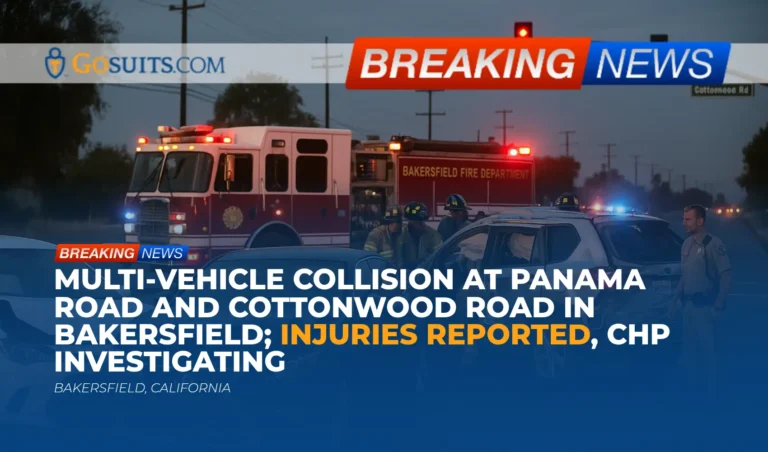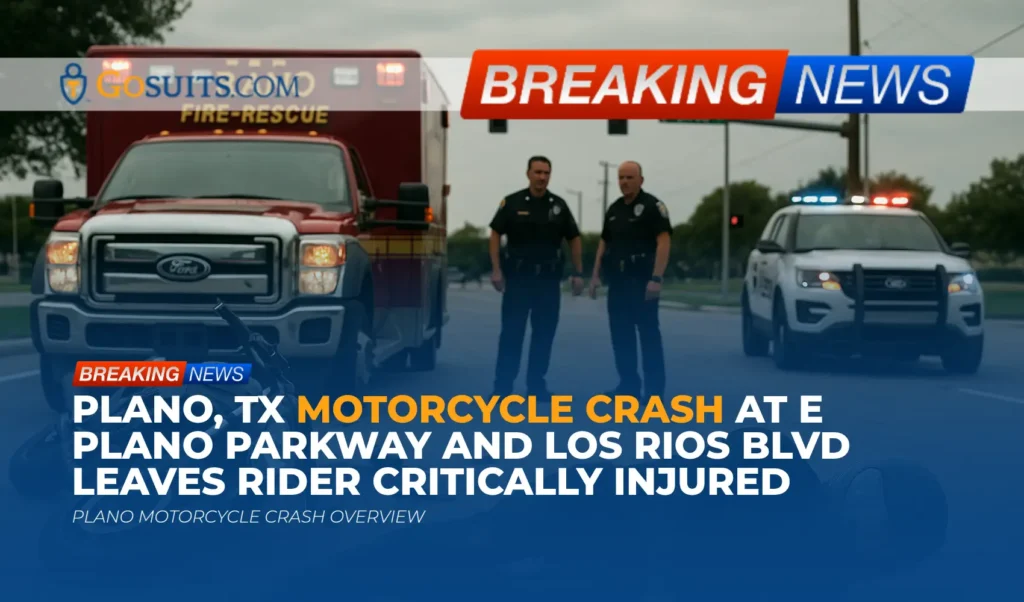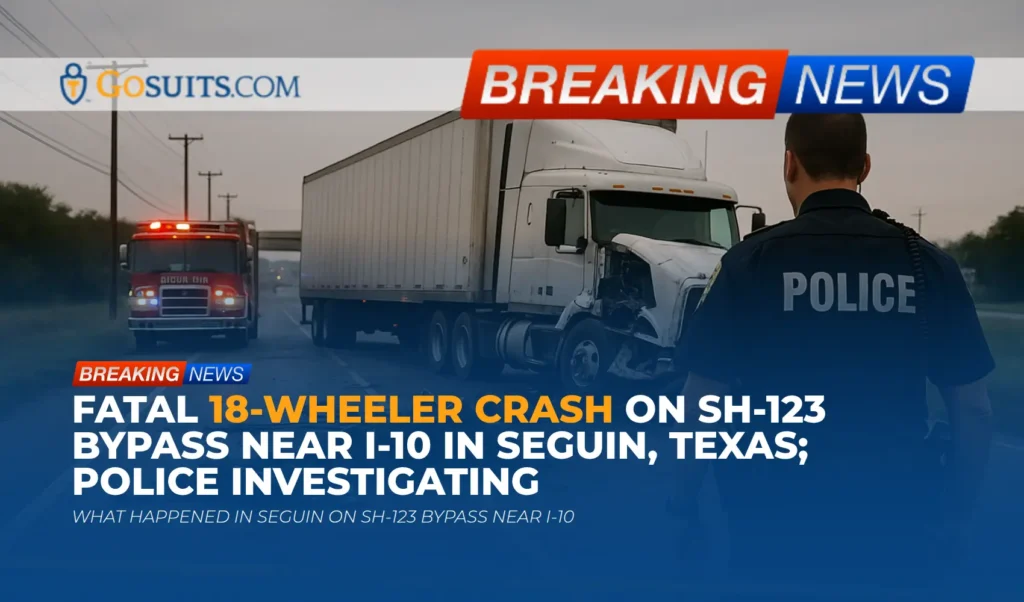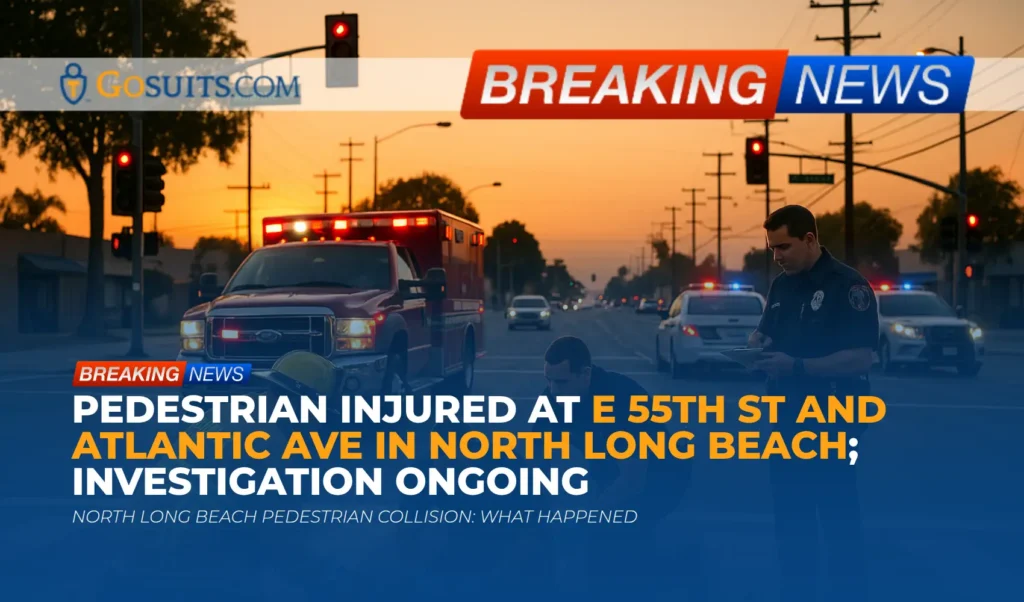- Overview of the reported crash at Panama Road and Cottonwood Road
- What is known so far from public reporting
- Immediate safety and investigation response
- Why multi-vehicle intersection crashes can be severe
- Key rights and careful first steps after a serious collision
- How to obtain official records and documents
- Civil liability considerations under California law
- Insurance considerations and common pitfalls
- Preserving crucial evidence
- Medical care, documentation, and privacy
- Important time limits for California claims
- Community safety and roadway context
- Commentary from Gosuits Bakersfield, California Personal Injury Attorney
- Time-sensitive next steps
Overview of the reported crash at Panama Road and Cottonwood Road
On Tuesday evening, October 21, 2025, a multi-vehicle collision was reported at the intersection of Panama Road and Cottonwood Road in Bakersfield, California. According to early information, three vehicles were involved: a Toyota, a Lexus sedan, and a Nissan SUV. At least one person was reportedly trapped inside a vehicle and required rescue, and at least one person was transported to a nearby hospital for treatment. The California Highway Patrol is investigating. The cause has not been announced, and the condition of the injured person or persons has not been publicly confirmed. Local deputies and Kern County Fire personnel responded to assist, and traffic closures were put in place for a time before roads reopened.
These developing facts, though limited, reflect a serious event for those involved and their families. The discussion below explains how crash investigations typically proceed, what rights injured people and families have under California law, where to obtain official records, and steps to consider in the days ahead.
What is known so far from public reporting
Time, location, and vehicles
The collision occurred just before 9 p.m. near the intersection of Panama Road and Cottonwood Road in Bakersfield. A Toyota, a Lexus sedan, and a Nissan SUV were reported to be involved. Significant damage was observed on at least two vehicles.
Injuries and rescue
At least one individual was pinned and required rescue. At least one person was transported to a nearby hospital. No public update on patient conditions was available at the time of the initial report.
Agency response and status
The California Highway Patrol (CHP) is investigating. Kern County Sheriff’s deputies and Kern County Fire Department personnel were on scene providing assistance and scene safety. Nearby roads were temporarily closed and later reopened. The cause of the crash remains under investigation, and no fault determinations have been announced.
Immediate safety and investigation response
In serious multi-vehicle collisions, law enforcement prioritizes medical aid, scene safety, and evidence preservation. CHP typically documents the scene, identifies involved parties and witnesses, and may coordinate with fire and EMS for extrication and transport. When injuries are reported, a CHP traffic collision report is usually created, capturing involved vehicles, roadway conditions, preliminary statements, and diagrams. The final collision report may include findings regarding contributing factors, though those determinations can take time and are subject to revision as evidence develops.
Families often want to understand how and why a crash happened. While answers may take time, it can help to gather available records, photographs, and witness information as soon as possible. California’s public processes provide ways to obtain collision reports, medical records, and—where a fatality occurs—coroner and vital records, each discussed below.
Why multi-vehicle intersection crashes can be severe
Intersections concentrate turning, crossing, and merging movements, which can raise the risk of high-impact collisions, especially when visibility is limited or speeds are high. Federal roadway safety research notes that a substantial share of serious harm occurs at or near intersections. The Federal Highway Administration reports that about one-quarter of traffic fatalities and roughly half of injury crashes occur at or near intersections, underscoring the heightened risk at these locations. See the FHWA’s intersection safety overview for context at safety.fhwa.dot.gov/intersection/.
In multi-vehicle crashes, forces can compound as secondary impacts occur, occupants face side-impact exposure, and there may be entrapment requiring specialized rescue. Nighttime conditions can further influence visibility and driver perception-reaction times. Because these dynamics can be complex, investigators often evaluate lighting, traffic control devices, sight lines, vehicle speeds, impact angles, and the sequence of events to understand causation.
Key rights and careful first steps after a serious collision
After a serious crash, the path forward can feel overwhelming. The following rights and steps are important to understand generally under California law. This is educational information and not a substitute for speaking with a qualified professional about a specific situation.
- Medical care comes first, then documentation. Health and safety are the top priority. Once stabilized, keeping copies of discharge summaries, imaging, prescriptions, and follow-up recommendations can help document injuries and their impact.
- Obtain the official collision report. For crashes investigated by CHP, collision reports can be requested by involved parties or their legal representatives. CHP explains the process and eligibility for collision report requests here: chp.ca.gov/Programs-Services/Programs/Collision-Records-Recovery.
- Report the crash to DMV when required. California requires a Traffic Accident Report (SR-1) to the DMV within 10 days if anyone was injured or property damage appears to exceed $1,000, even if law enforcement also took a report. The DMV provides details and the form here: dmv.ca.gov/portal/…/report-a-traffic-accident-to-dmv-sr-1.
- Use care with insurance communications. Insurance adjusters may seek recorded statements quickly. Statements can affect later evaluations of fault and damages. It is prudent to speak with a seasoned attorney in a free consultation before giving any detailed statement.
- Preserve evidence. Photos, dashcam files, vehicle location information, and contacts for witnesses can become pivotal. Vehicle “black box” data, if present, may record speed, brake, and throttle inputs in the moments before impact. The National Highway Traffic Safety Administration discusses event data recorders (EDRs) here: nhtsa.gov/equipment/event-data-recorders.
How to obtain official records and documents
CHP traffic collision report
Involved parties and their representatives may request the CHP traffic collision report once it is available. CHP provides an overview of collision records recovery, including eligibility and request steps, at chp.ca.gov/Programs-Services/Programs/Collision-Records-Recovery. To identify the correct area office handling the investigation, see the CHP’s office finder at chp.ca.gov/find-an-office.
DMV accident reporting (SR-1)
When injuries are involved, California requires submitting an SR-1 within 10 days, even if a law enforcement report exists. The DMV’s guidance and form access are provided at dmv.ca.gov/…/report-a-traffic-accident-to-dmv-sr-1. This is an administrative filing and does not assign fault.
Coroner and autopsy information (in the event of a fatality)
If a collision results in a fatality, the county coroner is charged with certain investigative responsibilities under California law. California Government Code section 27491 outlines circumstances under which a county coroner investigates deaths and may order an autopsy. The statute can be reviewed here: leginfo.legislature.ca.gov/…/27491.
Next of kin typically can request information about the cause and manner of death once available, and certified copies of death certificates are issued through vital records. The California Department of Public Health describes how to obtain certified copies of vital records, including death certificates, at cdph.ca.gov/…/Vital-Records-Obtaining-Certified-Copies.aspx.

Fire department incident records
Local fire departments may maintain incident records for rescues, medical response, and scene safety actions. Request procedures vary by agency. When coordinating requests, provide the incident date, approximate time, location, and, if available, a service call or incident number.
Hospital and medical records
Patients and personal representatives generally have a right of access to medical records under federal law. The U.S. Department of Health and Human Services provides guidance on the HIPAA right of access at hhs.gov/hipaa/…/access. Hospitals often have a Health Information Management or medical records department to handle requests.
Civil liability considerations under California law
At an intersection involving multiple vehicles, determining responsibility can require careful review of right-of-way, signals, speed, roadway design, visibility, driver attentiveness, and vehicle conditions. Several civil law principles may be relevant in California.
- Negligence and duty of care. Drivers have a duty to use reasonable care, obey traffic controls, and maintain a proper lookout. Breach of that duty that causes harm can lead to civil liability for resulting damages.
- Comparative fault. California applies comparative fault principles, meaning financial responsibility may be allocated among multiple parties according to their share of fault. This can include drivers, and in some cases, other entities if evidence shows a contributing hazard.
- Wrongful death claims. If a life is lost, certain family members may bring a wrongful death action under California Code of Civil Procedure section 377.60, available at leginfo.legislature.ca.gov/…/377.60.
- Public entity issues. If a claim involves a roadway condition or public-entity vehicle, specialized notice rules may apply under the Government Claims Act. As one time limit example, Government Code section 911.2 sets a six-month deadline to present certain claims to a public entity before suit. See leginfo.legislature.ca.gov/…/911.2.
Every collision is unique. Until the CHP completes its investigation and all evidence is reviewed, no definitive conclusions should be drawn about cause or responsibility.
Insurance considerations and common pitfalls
Insurance processes begin quickly after a crash. While prompt notice is important, it is also important to protect one’s rights.
- Talk with an attorney before giving a recorded statement. Anything said to an insurer can be used later to minimize or dispute a claim. A free consultation can clarify what information must be shared and how to avoid misunderstandings.
- Understand multiple policies may apply. Liability coverage from one or more drivers, uninsured/underinsured motorist coverage, and medical payments coverage can overlap in multi-vehicle crashes. Coordinating benefits takes care.
- Do not rush to a quick settlement. Early offers may not account for future medical care, therapy, wage loss, or long-term effects. Once a release is signed, reopening the claim is usually impossible.
- Document all losses. Keep bills, pay stubs, repair estimates, and notes on pain, sleep, and limitations. Thorough documentation often changes how a claim is evaluated.
Preserving crucial evidence
Strong claims are built on preserved evidence. Consider the following practices, which can be coordinated by counsel where appropriate.
- Photographs and video. Capture vehicle positions (if available), debris fields, skid or yaw marks, traffic control devices, damage angles, and lighting conditions.
- Witness information. Collect names, phone numbers, and brief statements from those who saw the collision or its aftermath.
- Vehicle preservation and EDR data. Modern vehicles may store pre-crash data. Preserving the vehicle in its post-collision condition can be critical for downloads and inspections. NHTSA’s overview of EDRs is at nhtsa.gov/equipment/event-data-recorders, and technical requirements appear in 49 C.F.R. Part 563 at the eCFR: ecfr.gov/…/part-563.
- Public records. Request the CHP collision report, relevant 911 audio, and any available dispatch logs. Some records have access limits, but timely requests help prevent loss.
- Medical trajectory. Keep a journal of symptoms, limitations, and how injuries affect daily activities and work. This helps connect medical records to lived experience.
Medical care, documentation, and privacy
Medical attention after a crash often spans emergency care, diagnostic imaging, follow-up with specialists, and therapy. Following provider recommendations, attending appointments, and completing therapy can protect health and create a clear record of recovery needs. Gaps in care are sometimes used by insurers to question the severity or cause of injuries.
Patients and personal representatives generally can obtain medical records, imaging, and billing under the federal HIPAA right of access. The U.S. Department of Health and Human Services outlines this right here: hhs.gov/hipaa/…/access. Hospitals may require proof of identity or representative status for release.
Important time limits for California claims
- DMV reporting. File the SR-1 with the DMV within 10 days when required by law. See dmv.ca.gov.
- General personal injury deadline. In many cases, the statute of limitations for personal injury in California is two years from the date of injury. See California Code of Civil Procedure section 335.1 at leginfo.legislature.ca.gov/…/335.1 and the California Courts Self-Help overview on limitation periods at selfhelp.courts.ca.gov/going-court/statutes-limitations.
- Wrongful death. Wrongful death claims are generally subject to a two-year deadline from the date of death. See California Code of Civil Procedure section 335.1 and section 377.60 at leginfo.legislature.ca.gov/…/377.60.
- Public entity claims. If a governmental entity may be involved, a written claim typically must be presented within six months. See Government Code section 911.2: leginfo.legislature.ca.gov/…/911.2.
Deadlines can be shorter or longer depending on specific facts, the parties involved, and the type of claim. Missing a deadline can bar a claim. Prompt, informed action helps protect rights.
Community safety and roadway context
Panama Road and Cottonwood Road are significant local corridors serving residential areas, schools, and businesses. Evening traffic can include commuters and local trips, and nighttime driving presents unique challenges. Federal guidance highlights strategies that reduce intersection harm, such as high-visibility signal backplates, improved lighting, protected turn phases, and access management. The FHWA intersection safety resource provides an overview at safety.fhwa.dot.gov/intersection/.
While only investigators can determine cause in this specific event, community safety is supported when drivers maintain safe speeds, yield as required, avoid distractions, and approach intersections with heightened caution, especially after dark.
Commentary from Gosuits Bakersfield, California Personal Injury Attorney
Our hearts are with everyone affected by the collision reported at Panama Road and Cottonwood Road. Learning that someone was pinned and that people were taken to a hospital is deeply concerning, and we hope for steady recovery. This discussion is provided for educational purposes and general information to help the community understand what typically follows a serious crash and what steps can protect one’s rights.
Based on what is publicly known, this was a serious multi-vehicle crash at an intersection in evening hours. In our experience, collisions like this can involve complex sequences: one initial impact leading to secondary impacts, challenging visibility, and split-second decision-making. It takes time for CHP to finalize collision reports, and additional evidence—such as photographs, surveillance video, 911 data, and event data recorder information—can significantly clarify what happened. As facts develop, careful attention should be paid to right-of-way and traffic control, impact angles, speed, line of sight, and any contributing roadway or vehicle issues.
Insurance companies and large corporations have seasoned teams that move quickly. They may contact people soon after a crash seeking recorded statements or medical authorizations that are broader than necessary. Early statements can be taken out of context and later used to minimize fault or downplay the seriousness of injuries. Similarly, early settlement offers may come before the full scope of medical needs is known. Understanding policy language, coverage coordination, and how damages are evaluated can be difficult without guidance.
A confidential, no-cost consultation with a skilled attorney can help clarify rights, identify coverage, preserve evidence, and map out timelines. Speaking with counsel before engaging in detailed insurance communications can prevent avoidable missteps. The goal at this stage is to make informed decisions, protect health and well-being, and ensure that the facts are preserved so the truth of what happened can be shown.

Time-sensitive next steps
The following actions help protect safety, health, and legal options after a serious multi-vehicle intersection collision. Acting promptly matters because evidence can be lost and deadlines apply.
- Prioritize medical care and follow-ups. Attend all appointments, follow discharge instructions, and report new or worsening symptoms. Early care supports recovery and creates a clear medical record.
- Secure the CHP report information. Note the CHP incident number and responding area office, and calendar a reminder to request the collision report when available.
- Complete required DMV reporting. If injuries occurred or property damage appears to exceed the threshold, submit the SR-1 within 10 days as required by the state.
- Preserve vehicles and data. Ask that involved vehicles be preserved in their post-crash condition until inspections and any EDR data downloads can be arranged. Written preservation notices help prevent spoliation.
- Collect and organize evidence. Save photographs, dashcam or home/business surveillance, 911 call times, and contact details for witnesses. Back up files to more than one location.
- Be cautious with insurer communications. Speak with an attorney for a free consultation before giving a recorded statement. What is said can affect fault and valuation later.
- Track all losses. Keep receipts for medical costs, towing and storage, rental cars, and out-of-pocket expenses. Document missed work and impacts on daily activities.
- Consider specialized claim timelines. If a roadway condition or public entity vehicle may be involved, calendar the six-month Government Claims Act notice window while facts are being gathered.
- Support loved ones. Share updates, plan transportation and appointments, and keep a calm, accurate record of events and contacts. This reduces stress and confusion during recovery.
Where to call for specific records or updates
- California Highway Patrol (collision report): Identify the area office and request the report per CHP process described at chp.ca.gov/Programs-Services/Programs/Collision-Records-Recovery.
- DMV SR-1 filing: Review requirements and submit as directed by the DMV at dmv.ca.gov.
- Hospital medical records: Contact the hospital’s Health Information Management/Medical Records department; see HIPAA right of access guidance from HHS at hhs.gov/hipaa/…/access.
- Coroner and vital records (if applicable): Next of kin can coordinate with the county coroner consistent with California Government Code section 27491, and request certified death certificates through the California Department of Public Health at cdph.ca.gov.
Why timely action matters
Evidence such as skid marks, debris fields, surveillance recordings, and vehicle data can be lost or overwritten within days or weeks. Witness memories fade quickly. Meanwhile, California imposes strict time limits on administrative and civil claims. Taking organized steps now preserves options later, whether the goal is to obtain answers, address medical bills, or pursue accountability through the civil system.






